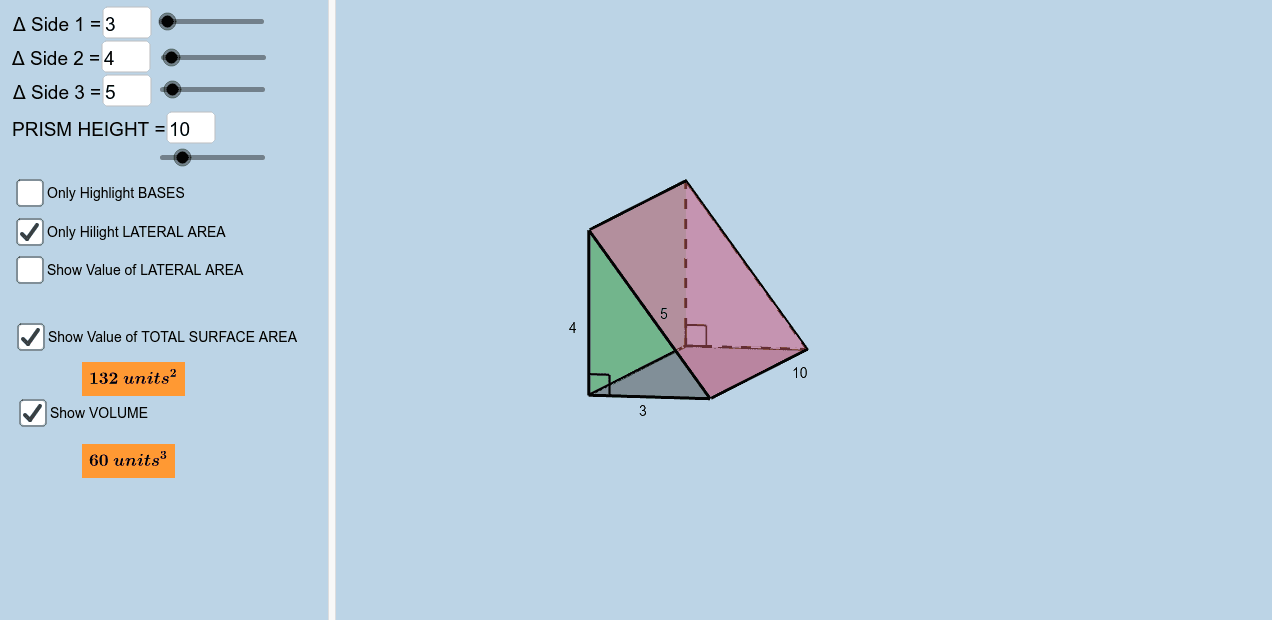

The lateral surface area of the right triangular prism (LSA) = ah + bh + ch (or) (a + b + c) h, where a, b and c are the bases of the rectangular faces and h is the common height or the total height of the prism.
#Surface area calculator triangular prism how to#
How to Find the Lateral Area of a Right Triangular Prism? The formula to find the lateral area of a triangular prism is, (a + b + c) h or Ph. Thus, the lateral area of a triangular prism is the sum of the side faces, that is the three rectangular faces. We know that the lateral area of any prism is the sum of the areas of its side faces. What Is the Formula To Find the Lateral Area of a Triangular Prism? The lateral area of a prism of height h where the dimensions of the triangular bases are a, b, and c is (a + b + c) h. The lateral surface area of a triangular prism is the sum of the areas of all its side faces which are 3 rectangles. What Is the Meaning of the Lateral Surface Area of a Triangular Prism? A triangular prism has 3 lateral faces that are rectangles. Which Polygon Is a Lateral Face of the Triangular Prism?Įach lateral face (side face) of a triangular prism is a rectangle.

The "bases" of a triangular prism are the triangles (which are congruent and parallel) that lie on the top and bottom of the prism whereas the "lateral faces" are the side faces (all faces other than the "bases") that are rectangles. How Is a Lateral Face of a Triangular Prism Different From a Base? The base of each of these rectangles coincides with one side of the triangular base. All these rectangles have the same height. The lateral faces of a triangular prism are rectangles. The area of a regular pentagon is found by \(V=(\frac\times2\times1.5)=1.5\), rewrite the equation using this product.FAQs on Lateral Area of Triangular Prism What Are the Lateral Faces of a Triangular Prism? This formula isn’t common, so it’s okay if you need to look it up. We want to substitute in our formula for the area of a regular pentagon. Remember, with surface area, we are adding the areas of each face together, so we are only multiplying by two dimensions, which is why we square our units.įind the volume and surface area of this regular pentagonal prism. Remember, since we are multiplying by three dimensions, our units are cubed.Īgain, we are going to substitute in our formula for area of a rectangle, and we are also going to substitute in our formula for perimeter of a rectangle. When we multiply these out, this gives us \(364 m^3\). Since big B stands for area of the base, we are going to substitute in the formula for area of a rectangle, length times width. Now that we know what the formulas are, let’s look at a few example problems using them.įind the volume and surface area of this rectangular prism. The formula for the surface area of a prism is \(SA=2B+ph\), where B, again, stands for the area of the base, p represents the perimeter of the base, and h stands for the height of the prism.

We see this in the formula for the area of a triangle, ½ bh. It is important that you capitalize this B because otherwise it simply means base. Notice that big B stands for area of the base. To find the volume of a prism, multiply the area of the prism’s base times its height. Now that we have gone over some of our key terms, let’s look at our two formulas. Remember, regular in terms of polygons means that each side of the polygon has the same length. The height of a prism is the length of an edge between the two bases.Īnd finally, I want to review the word regular. Height is important to distinguish because it is different than the height used in some of our area formulas. The other word that will come up regularly in our formulas is height.

For example, if you have a hexagonal prism, the bases are the two hexagons on either end of the prism. The bases of a prism are the two unique sides that the prism is named for. The first word we need to define is base. Hi, and welcome to this video on finding the Volume and Surface Area of a Prism!īefore we jump into how to find the volume and surface area of a prism, let’s go over a few key terms that we will see in our formulas.


 0 kommentar(er)
0 kommentar(er)
